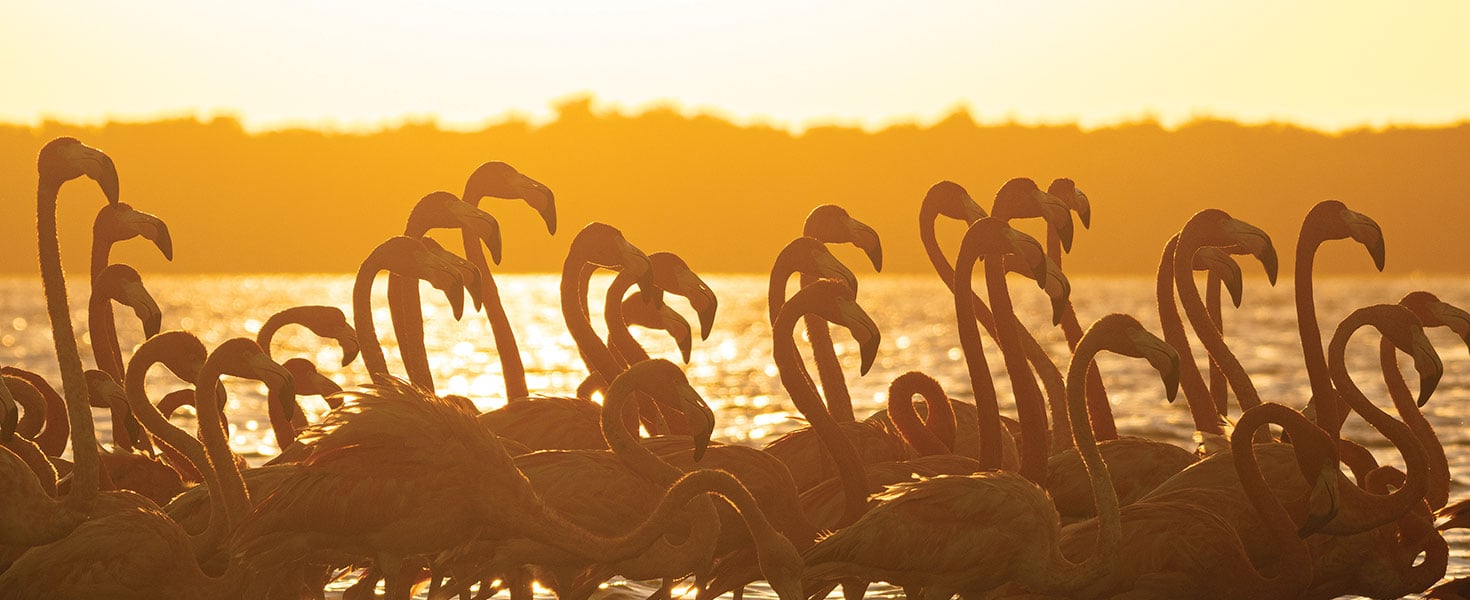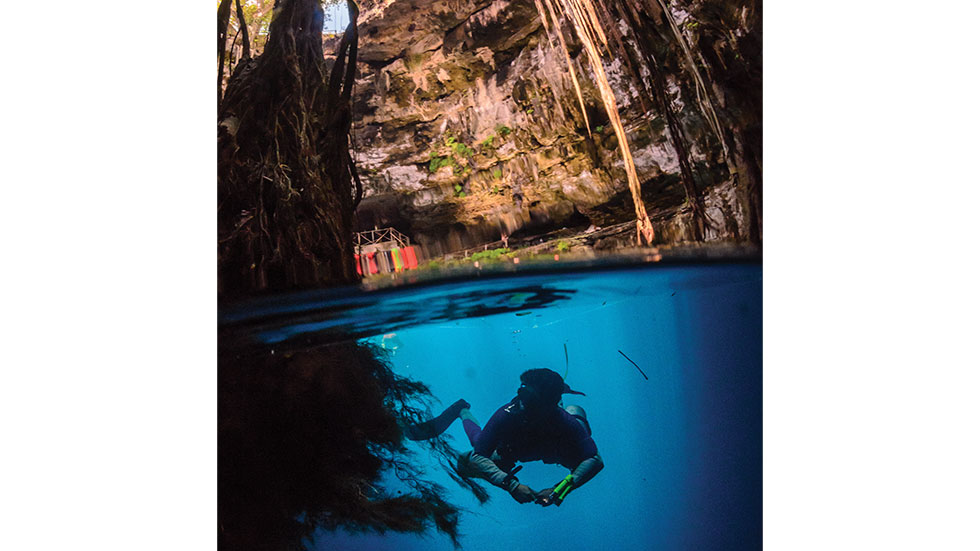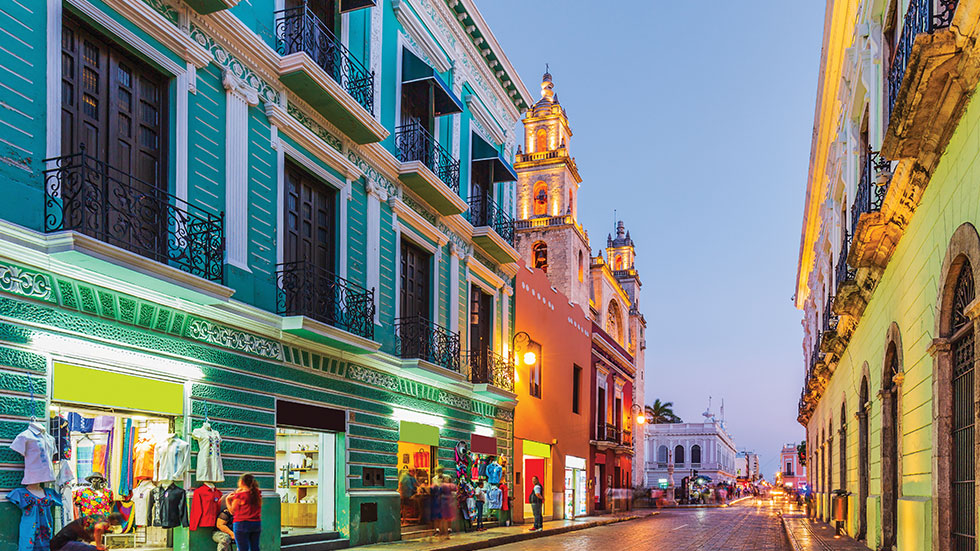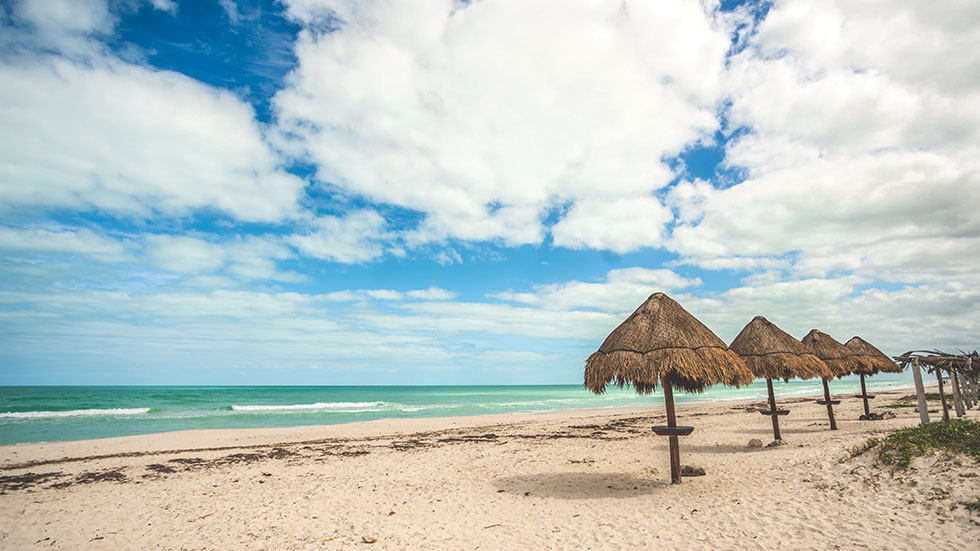The Wonders of the Yucatán
Uncrowded beaches, exceptional nature preserves, and ancient ruins make Mexico’s state of Yucatán a must-visit marvel

Shortly after dawn on a warm March morning in Mexico’s Yucatán state, I climbed down 72 concrete steps for a swim in a cenote, a freshwater sinkhole partly open to the sky. Fish scattered when I stepped into the cool turquoise water from a wooden platform. As I floated, I watched bats and birds darting swiftly across the sky or perched in tiny crevices or atop small natural shelves on the steep limestone walls that partially enclosed the cenote.
With my ears submerged, I was enveloped in silence, thrilled to be alone in this cavernous, ancient space. Long vines, some with vegetation still attached, hung from the limestone walls. I thought of the ancient Mayans who revered these underground water sources, built their communities nearby and practiced sacred rituals, sometimes even human sacrifices, in the cenotes.
Sometimes located inside caves, the cenotes are part of a subterranean water system that underlies the limestone bedrock of the region. They are situated along the edges of the giant Chicxulub crater, formed some 65 million years ago when an asteroid about six miles in diameter struck the earth. In Yucatán state alone, there are more than 3,000 cenotes, though far fewer are easily accessible to the public.
Cenotes are emblematic of the region. They are part historical, part religious, all stunning natural wonders that help fuel the local economy through tourism.
 Scuba diving in a cenote. Photo by Manuel Marin
Scuba diving in a cenote. Photo by Manuel Marin
NATURAL ATTRACTIONS
Yucatán state, with more than 200 miles of coastline along the Gulf of Mexico, is bordered by the states of Campeche and Quintana Roo, where you’ll find well-known tourist destinations such as Cancún and the Riviera Maya. All three states are part of the Yucatán Peninsula at Mexico’s southeastern tip.
The state of Yucatán doesn’t have the big resorts or attract the crowds that head to the Riviera Maya, and that’s part of its appeal to travelers, including my husband and me. It’s best known for the famed Mayan ruins of Chichén Itzá and its jewel of a capital city, Mérida, but tourism officials say ecotourism is drawing visitors here as well. Visitors are attracted to its sleepy beach towns and protected natural areas, where you can see animals such as crocodiles, turtles and the pink flamingos that congregate in this area, sometimes in the tens of thousands.
The state’s road systems are a great way to see its many natural wonders, said Michelle Fridman, Yucatán’s tourism minister. And indeed, despite the sometimes-wonky GPS, which meant my husband and I missed a few turns and had to backtrack, we found that renting a car was the best way to get to the places we wanted to go.
“With so many parts of the state of Yucatán still untouched by the impact of human activity, nature is an important part of what we offer both guests and locals,” Fridman added. She noted that Yucatán is home to nearly 600 bird species in a comparatively small piece of land.
 Old Town Mérida. Photo by Scstock/stock.adobe.com
Old Town Mérida. Photo by Scstock/stock.adobe.com
FIRST STOP: MÉRIDA
My husband and I had started our Yucatán exploration by flying into Mérida, where we spent a few days at the boutique hotel Wayam Mundo Imperial, a modern, comfortable space adorned with whimsical wooden sculptures. The hotel’s Cuna restaurant has terrific food focused on local ingredients with a contemporary twist. Don’t miss the Mayan octopus toast or the margarita that comes with an upside-down popsicle in the glass.
We arranged a day tour to the Ria Celestún Biosphere Reserve, about 60 miles away, to see the nearly 150,000-acre wetland with its mangrove forests and swamps. The ecosystem’s mix of fresh and salt water is home to turtles, crocodiles and more than 300 bird species. While there, we took a boat tour with a local guide to see wading and flying flamingos and ride through a tunnel of mangroves. We were lucky to see a crocodile not too far from the boat. If you’re up for it, there’s time for swimming in a spring-fed freshwater pool at the edge of the mangroves.
The next day in Mérida, we checked out the Yucatán food scene and ate way more than anyone should. But it was hard to say no to seconds when chef Miriam Peraza Rivero at Manjar Blanco offered classic cochinita pibil, pork shoulder in a zingy marinade wrapped in banana leaves and cooked for hours in a pit of hot coals.
 El Cuyo beach on the Gulf of Mexico. Photo by Oscarloro/stock.adobe.com
El Cuyo beach on the Gulf of Mexico. Photo by Oscarloro/stock.adobe.com
NEXT UP: EL CUYO
After three nights in Mérida, we picked up a rental car and headed to El Cuyo, a sleepy beach town on the Gulf of Mexico. It has no stoplights, few paved roads, no chain restaurants and just a few small hotels.
Kite surfers from around the world started coming to El Cuyo a decade ago because of its shallow coastal waters and strong winds, particularly evident between November and July. We were fascinated by the kite surfers maneuvering their brightly colored kites as they skipped across the water while barely seeming to touch the surface. If you’re tempted to join them, several places in town offer lessons.
The delightful food options in El Cuyo include the high-end El Chile Gordo, where the menu changes seasonally and chef Oscar Flores offers a reservations-only tasting menu that provides a flavorful, artfully presented culinary tour of Mexico. Standouts of our dinner included Flores’ takes on ceviche, tacos, chile relleno and three kinds of mole.
And don’t miss the healthy breakfast options at Naia Café and Restaurant or the grilled meats and mojitos at Zapote Bar Asador, where the food is cooked over an open fire behind the restaurant.
We stayed in a basic but comfortable two-bedroom house right on the beach, part of the Casa del Ritmo group that includes a small hotel, rental houses and camping sites. Be sure to have plenty of pesos on hand in El Cuyo, as intermittent internet means that ATMs and credit card machines don’t always work.
One day while there, I indulged in a Mayan mud bath just a short distance away by guided boat ride. The guide and I traveled through an estuary to a small spit of land where we pulled watery clay from a foot-deep hole. We slathered it on our faces and bodies and then boated back to town as the mud dried. Arriving at the harbor, we washed it off in the shallow waters. The mud is said to nourish your skin, and I must admit that my skin felt incredibly soft afterward.
 Temple of Kukulcán at Chichén Itzá. Photo by Unai/stock.adobe.com
Temple of Kukulcán at Chichén Itzá. Photo by Unai/stock.adobe.com
STANDOUT EXCURSION: CHICHÉN ITZÁ
The highlight of our trip to Yucatán came on the day that started with that swim in the cenote. We had booked an Airbnb stay at the Hacienda San Lorenzo Oxman, outside Vallodolid, about 70 miles from El Cuyo. The hacienda is an 18th-century Spanish-style building offering two rooms for overnight stays that come with early access to the cenote, which was the big attraction for us. The pool and restaurant/bar at the hacienda are near the cenote entrance and popular with day-trippers.
The hacienda and cenote are just a short drive from Yucatán’s great human-made wonder: Chichén Itzá, the remains of a Mayan city-state that flourished intermittently from about 600 to 1200 AD. With the massive pyramid-shaped Temple of Kukulcán at its center, the site is a stunning testament to the Maya civilization’s engineering sophistication.
More than two million people visit this UNESCO World Heritage Site annually. With that in mind, arrive as soon as possible after the 8 a.m. opening to beat the crowds and the tropical heat. We delayed until after 9 a.m. and were met with swarms of other travelers. We were glad that we’d hired a local guide to show us around.
Seeing what the Mayans left behind is an awe-inspiring experience. The combination in one day of swimming in a cenote and exploring Chichén Itzá brought home to me the truth of travel’s ability to heighten the senses and connect the present with the past. In Yucatán state, this truth unfolds as effortlessly as a flamingo spreading its wings.
